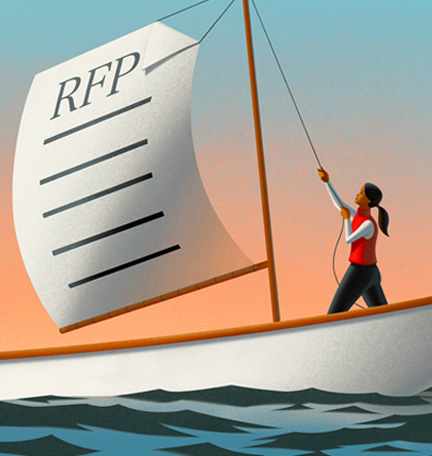Retirement may not seem like a time to introduce more risk into your investments. But a healthy balance may actually benefit you.
As a retiree, you need your retirement and investment portfolios as your source of income, so it makes sense that you would want to reduce risk and protect against losses (preserve capital). However, as the average retirement lasts longer, it can be more important than ever to keep a portion of your portfolio allocated to growth.
Income Versus Growth: Striking a Balance
Most people start investing in order to grow their savings before retirement. They look for investments such as stocks that they hope will increase in value. These are considered growth portfolios. But there is another type of investing portfolio — an income portfolio – which is designed to preserve capital and pay a semi-regular income.
Many retirees switch to income portfolios because they hope to live off their nest egg. Ideally, they’ve saved enough to retire comfortably and they tend to be less concerned with growth while more focused on capital preservation and potential income.
However, you never know what the future holds. It can be smart to keep a portion of your portfolio invested in assets you hope will grow over time by combining the principles of growth and income portfolios.
For example, a young investor’s portfolio may be 75 percent focused on growth; he has a long time until retirement and can take on more risk because he has a longer period of time to recoup losses before retirement. However, he might keep 25 percent of his portfolio focused on income to help diversify his investments. The young investor may reinvest any investment income he earns, rather than spend it, to benefit from compounding. Or the young investor may also use those earnings to save for a large expense, such as the down payment on a home.
On the other hand, an older investor who plans to live off retirement savings may focus the majority of his portfolio on income and less on growth. This offers some protection if he lives a long life or incurs any unexpected expenses.
“Many factors come into consideration: net worth, cash flow needs, time horizon, liquidity needs, risk profiles, financial goals and, most importantly, health,” says Francisco Fernandez, CFP®, Vice President and Financial Advisor at Regions Investment Solutions in Miami, Florida. “In general, I would recommend reviewing the current portfolio and making sure it is aligned with his or her risk profile and investment objectives. We can tweak, rebalance or reallocate the current portfolio as needed.”
Ultimately, how much of your portfolio you allocate to growth during your retirement depends on your personal circumstances. Here are a few things to consider.
1. Risk Tolerance: Stocks
The primary difference between growth and income portfolios is the types of assets in each. Stocks (or equities) and bonds (or fixed income) are generally the two primary asset classes in most portfolios. Since stocks and bonds react differently to changes in the market and economy, including both helps diversify risk in a portfolio. Some portfolios include additional assets beyond stocks and bonds for this same reason. A diversified portfolio does not assure a profit or protect against loss in a declining market.
For retirees, the instinct may be to focus on dividend stocks, which pay a portion of the company’s earnings. They ideally provide income each quarter. But shifting all of your stock investments away from other stocks could mean missing out on some potential growth. Depending on how much risk you’re comfortable with, you might consider keeping some of your money invested in growth-oriented options, with the goal of continuing to grow your portfolio in retirement—particularly if losses would not adversely impact your retirement goals.
2. Risk Tolerance: Bonds
Fixed income investments, including bonds, are considered safer than stocks. Depending on their quality and ratings, bonds tend to offer capital preservation. When you buy a bond for $1,000, you are essentially giving the bond issuer a loan that the issuer agrees to pay back at the end of the bond’s term — known as maturity. Like with a loan, the bond issuer pays a set amount of interest, known as fixed income, to bondholders.
Keep in mind that government debt, or highly-rated municipal or corporate debt, tends to be relatively low risk. Each bond you buy will come with a rating to help you assess how much risk is involved. AAA is the highest rating. The lowest-rated bonds tend to pay the highest yield. This has to do with risk: Issuers need to pay investors a higher return in exchange for the risk they are taking on.
Bonds aren’t the only way to incorporate fixed income into your portfolio. Certificates of Deposit (CDs) and Money Market accounts which are FDIC-insured, are also a fixed income investments, which may see higher yields as interest rates increase.
3. Outlook
What you include in your portfolio, and how much risk you take on, should be influenced by your outlook for the stock market and the economy.
For instance, bond yields tend to go up in a rising rate environment. Talk to your wealth manager about your expectations for the market and the economy, and shift your assets or risk if necessary. If, for instance, you anticipate a market downturn, you may want to protect yourself by shifting money from stocks into fixed income investments.
4. Life expectancy
It’s important to consider how long you may need to live off your retirement savings. If, for instance, your parents both lived well into their 90s, you may want to plan for a longer retirement. You may want to build more growth into your portfolio, as you could outlive your savings.
About a quarter of 65-year-olds today will live past age 90, and one out of 10 will live past age 95, according to the Social Security Administration. Women also tend to live longer than men by about two years.
How you balance and how much risk you take is a personal decision. But generally speaking, it’s a good idea to “spread the wealth” among a diverse group of assets. “I would strongly recommend having a well-diversified income portfolio across different sectors,” Fernandez says.
To talk to a wealth manager or learn more about planning for retirement, visit Regions.com/Insights.











